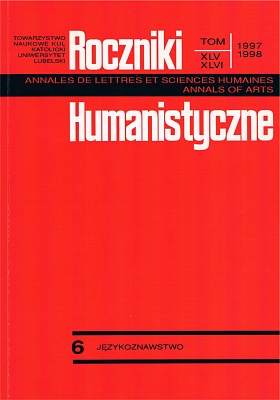Pojezierze Łęczyńsko-Włodawskie w świetle nazw jezior, stawów i bagien
Abstrakt
The names of lakes, ponds, and swamps, as presented in the paper, have been treated as the source to learn the historical ethnic relations between the settlers of the Łęczyńsko-Włodawskie Lakes. One can distinguish in those names several semantic groups.
There are among them the physiographic names, which − like the local names of a similar type - describe the natural features of the human environment. Apart from the names directed precisely at the water area, point to its shape (Długie, the Long lake), size (Wielkie − the Big Lake), depth (Głębokie − the Deep Lake), the colour of the water (Krasne − the Red Lake), salinity (Słone − the Salty Lake), restocking with fish (Karaśne − the Crucian Lake) and other features. There are names which inform about the closest surrounding of the water area: about the flora (Brzeziczno − The Birch Lake), about the features of the soil (Glinki − the Clay Lake, Piaseczno − the Sand Lake), about the location in the wild and inaccessible territory (Bieszcze, Ochoża). The groups of such names allow us to trace the territories of the primeval dearth of settlement.
The second group consists of water names pointing to human civilizational activity: the development of the territory (Paszenka − the Fodder Lake, Terebycz), tracing of paths and routes (*Bródno>Brudno, Ściegienne), hay economy (Ostwi(-y)sz, Gumien(-i)ek).
The frequent water names point to a direct relationship with settlements. They constitute a recurrence of the local names (Biesiadki, Dratów) or derived forms (Hańskie, Uścimowiec). Among this group of water names it is particularly worth noting those names which leave trace of the lost settlements: Cieszacin, Horodyszcze, Krzczeń, Sieluble > Wąskie, Lubowiż > Lubowież, Orchowo, Stawy Moraw(sz)cz(-e)ńskie. The names could be linked with the well-known colonization routes in this Lake District or they themselves trace them.
The last group constitute the names of ponds which were set up late. These are the names commemorating the real or fictitious figures (Kościuszko, Zagłoba, Syrena), distant places (Giewont, Wenecja − Venice), heavenly bodies (Kometa − Comet). Through this kind of signs the onomastic map of the territory under research makes part of the new trends of national, or even, European tradition, the trends which enrich the basic image of the local water names, stemming out of the local tradition.
It is not rare to come across the water names bearing Russian features (e.g. Bagno Bubnów, Cieszacin, Łukie, Perespa, Płotycze, and Terebycz) which make up the historical testimony of the ethnic relationships between the settlers of the border Polish-Russian territory.
Copyright (c) 1997 Roczniki Humanistyczne

Utwór dostępny jest na licencji Creative Commons Uznanie autorstwa – Użycie niekomercyjne – Bez utworów zależnych 4.0 Międzynarodowe.





